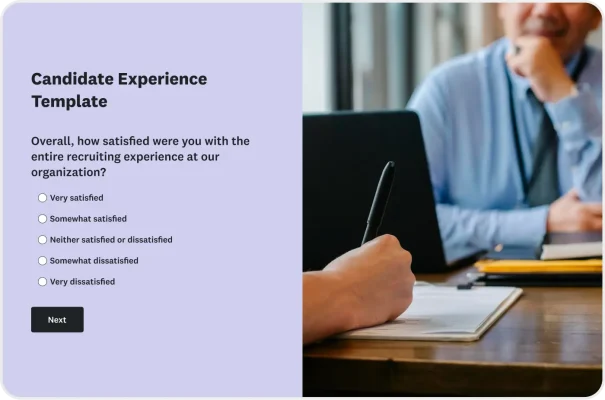Candidate Experience Survey Template
Improve your organization’s hiring process by gathering candidate feedback on their application and interview experience.
How does the Candidate Experience Surveys Template work?
Our Candidate Experience Survey Template helps HR teams gather valuable feedback to identify pain points and create a smoother, more inclusive recruitment experience.
Use this survey template to collect insights on the application, recruitment, and interview process. This will allow you to refine your hiring strategy and enhance candidate communication.
Benefits of candidate experience surveys
A positive candidate experience strengthens your employer brand, attracts top talent, and improves your hiring process.
Using candidate feedback, hiring managers and HR teams can:
- Build a stronger employer reputation
- Identify and eliminate friction points in the hiring process
- Promote fair and inclusive hiring practices
- Understand which benefits and perks are most important to candidates and new hires
Your team can create a more efficient, candidate-friendly interview and application experience with real-time insights from candidates.
25 sample candidate experience survey questions

These example candidate experience survey questions help evaluate key aspects of the selection process:
Overall hiring experience
1. How satisfied were you with the entire recruiting experience at our organization?
Use a Likert scale to provide a measurable scale of how your company performed during the recruiting process.
2. How would you rate your overall experience with our recruitment team?
This question will give your team insights into how well they did as one element of the recruitment experience, regardless of the outcome.
3. What, if anything, could have improved your experience?
Use an open-ended or multiple-choice question to uncover qualitative areas where you can improve the recruiting process.
4. Do you feel that the recruitment process accurately reflects our company values?
Attracting and hiring candidates who easily adapt to the workplace starts with their first interaction. Find out whether your recruiting experience is consistent with your brand.
Related: Recruitment Satisfaction Survey Template.
5. How likely are you to recommend our organization to others after experiencing our hiring process?
Asking an employee Net Promoter Score® (eNPS) question will help you measure candidates’ overall satisfaction with the interview process and their likelihood of advocating or promoting your brand.
6. How satisfied are you with the recruiter you worked with?
Feedback is good for everyone. Ask candidates how they felt about their individual recruiter, and use that feedback to help your recruitment team understand where they can improve.
Interview process and communication
7. How clearly did the recruiter describe the position?
Unclear job descriptions can lead to a hiring process that doesn’t recruit or retain candidates who are capable—or willing—to do the job. Knowing whether the candidate understands the role can boost job satisfaction and decrease turnover.
8. How clearly did the recruiter describe the interview process?
Knowing what comes next can reassure a candidate that things are moving forward. Find out if candidates are getting a clear explanation of the process from your recruiting team.
9. Did you receive timely updates on your application status?
Timely communication is important for candidates who are likely juggling a job or other opportunities. Ask this question to determine whether your recruitment process keeps candidates informed about their progress.
10. How professional were the interviewers?
Your interviewers are an extension of your company. To ensure your company is well represented, get the candidates' perspectives on whether they were on time, well briefed, and prepped for the interview.
11. How confident were you in the interviewers’ ability to assess your fit for the role?
Asking this question will help you determine if your interviewers have the tools to evaluate a candidate’s ability to succeed in a role.
12. Did you feel encouraged to ask questions about the role or company?
The goal of the interview is to learn more about the candidate—asking this question will give you insights as to whether your interviewers are giving candidates time to talk or simply telling them about the role.
13. How well did the interviewers listen to your responses and concerns?
Good communication has to go both ways. Find out if your interviewers listen to and respond appropriately to the candidate’s answers.
14. How prepared were the interviewers during your time with them?
Even if you provide interviewers with advance information, it’s hard to know who is actually using it. This question can help you evaluate your interviewers’ willingness to spend time preparing—and their commitment to the recruitment process.
15. How well did the interviewers allow you to highlight your strengths for the role?
Letting candidates describe their strengths is part of listening—but also knowing what questions to ask. Check with candidates on whether they were encouraged to talk about what they feel they can contribute to a role.
16. Did the interviewers leave you enough time to ask questions during the interview?
Good questions from candidates can uncover their concerns and expectations and, if properly addressed, can help you seal the deal. Asking if interviewers gave them time is a good way of making sure your addressing issues and concerns during the interview process.
Process and scheduling efficiency
17. How easy or difficult was it to schedule interviews?
Interviews should be convenient and efficient for the candidate. Understanding whether candidates feel the process was cumbersome can give you leverage with your interviewers to be more available.
18. Was the hiring process completed within a reasonable timeframe?
Candidates can only wait so long for a decision. The survey question above can help you determine if you are losing good candidates because you are taking too long to make an offer.
19. Were you given enough information about the next steps in the hiring process?
Lengthy interview cycles are more tolerable if candidates know what comes next. This question can help you evaluate how well you communicate the process to prospective hires.
20. Were there any technical issues or delays in the interview process (e.g., virtual interview challenges)?
Sometimes, a great interview can be marred by glitches in technology. Get feedback on how your systems function to deliver a functional and convenient experience.
Inclusion and fairness
21. Did you feel respected throughout the recruitment process?
Respect can be subjective. For some candidates, it might mean they weren’t kept waiting or that they were addressed politely. Ask this question and follow up with candidates who responded less positively to better understand the experience you deliver.
22. Did you feel the assessment methods used were relevant to the role?
The practice of pre-tests and assignments can vary widely; asking this question can help you uncover whether your assessment is appropriate or overkill.
Job and role requirements
23. Were the job requirements and role responsibilities clear to you from the beginning?
Candidates need to be clear on what is expected from the job description to the screening. This question can help you close any gaps between what is communicated and the actual role.
24. Were you given adequate information about the role and expectations during the recruitment process?
Candidates should learn more about the role as they progress through the process. Ensure your interviews are informative and help you understand if they have what they need to make a decision.
25. Did you feel the job description aligned with the responsibilities discussed during the interview?
One of the most important parts of hiring is ensuring candidates are prepared to do the job. After the interviews, find out if your candidates are prepared for the job responsibilities or surprised by them.
Related reading: A how-to guide for sending the best candidate experience surveys.
What does a candidate experience survey measure?
Candidate experience surveys measure applicant perceptions throughout the recruitment journey, from initial application to final decision. This data enables organizations to refine recruitment strategies, improve communication, and ensure a seamless selection process.
Here are five examples of metrics that HR teams can track to see if their recruitment process is successful:
Offer acceptance rate
The offer acceptance rate is the percentage of candidates who accept a job offer, which is table stakes for recruitment organizations. If your acceptance rate is low, it might mean your offers are not strong—or it could mean that your candidate experience needs to improve. Ensure your compensation plan is competitive and the interview experience you deliver is positive.
Application drop-off rate
This metric evaluates the percentage of candidates who start an application but don't complete it. It can identify whether an application process is too lengthy, complicated, or time-consuming. Consider simplifying the process or using a mobile application to help with drop-off.
Time to hire
Time to hire evaluates how long it takes for a candidate to receive an offer after applying. If it takes too long, your candidate might accept another offer, lose interest, or develop a negative impression of your company. To address this, try to streamline interviews and schedule them in a smaller window of time. Make sure you communicate with candidates throughout the process.
Candidate Satisfaction Score
A candidate satisfaction score (CSS) determines candidates' satisfaction with the recruitment process. Running a candidate satisfaction survey can help you pinpoint areas to improve in the recruitment process and how to deliver a more positive candidate experience.
Interview-to-Offer Ratio
An important measure of the recruitment process is measuring the ratio of candidates who are interviewed to candidates who receive an offer. If your ratio is low, it might mean that you’re being too selective or that your recruiting process isn’t surfacing the right candidates. Make sure your interviewers are being consistent with how you evaluate candidates and provide tools to come to a consensus if a lack of agreement is the problem.
Question types for candidate experience surveys
When collecting candidate feedback, it’s a good practice to use a variety of question types so you have both quantitative and qualitative feedback.
Multiple choice questions
This question format is easy for candidates to answer and easy to analyze the results. You’ll collect feedback that is consistent and reliable, as candidates will respond with the same answer choices.
Likert questions
Likert scale questions allow candidates to rank their answers on a scale by presenting them with a range of agreement or disagreement options. This approach helps measure attitudes and opinions, which are often subjective.
An example of a Likert question is:
How satisfied are you with the recruiting process?
- Very satisfied
- Satisfied
- Neither satisfied or dissatisfied
- Dissatisfied
- Very dissatisfied
Open-ended questions
Allow candidates to answer your questions in their own words to collect more detailed feedback. Open-ended questions allow you to gain new insights you would offer and gain a deeper understanding of candidate perspectives.
An example of an open-ended question is:
- What could we have done to improve the interview experience?
When to send candidate experience surveys
Timing matters when gathering candidate feedback. Send surveys immediately after key hiring stages to ensure accurate and thoughtful responses. Consider distributing surveys:
- After an interview
- After an offer is extended or declined
- After a candidate withdraws from the process
By capturing feedback while the experience is fresh, you gain actionable insights that help refine your hiring process.
Best practices for candidate experience surveys
To maximize the effectiveness of your candidate experience surveys, follow these best practices:
- Be timely: Send surveys immediately after key stages of the hiring process to ensure feedback is fresh and relevant.
- Keep surveys concise: It’s vital to respect the time of candidates. A well-structured survey with focused questions ensures higher response rates and clearer insights.
- Avoid leading and biased questions: Ensure that your questions remain neutral and objective to receive authentic insights. See these tips for avoiding common survey bias.
- Take action on feedback: Candidate feedback is only valuable if it leads to action. Insights gathered from surveys can be used to refine your recruitment process, address pain points, and improve communication
- Promote anonymity: Ensure candidates know their responses are confidential and won’t impact their future candidacy. Anonymous surveys encourage more candid, honest feedback.
- Tailor your questions by industry: Make sure you consider the candidate experience in specific sectors or industries. Some roles require advanced technical skills, industry knowledge, or certifications that should be a part of the evaluation process.
- Improve survey response rates: Try some of these best practices to collect more feedback from candidates, including keeping survey short, making questions easy to answer, and following up with email reminders:
Gather feedback with our Candidate Experience Survey Template
Enhance your organization’s hiring process with direct feedback from candidates. Our survey template provides HR professionals with a simple way to evaluate candidates’ opinions on the interview process, recruiter communication, and more. Get started today.
Net Promoter, Net Promoter Score, and NPS are trademarks of Satmetrix Systems, Inc., Bain & Company, Inc., and Fred Reichheld.
Explore related templates
Explore which features support this survey template
We have so many powerful features to help you launch surveys quickly, but here are our most popular ones for new users.
Customizable survey experiences
Out-of-the-box themes, accessible color palettes, custom fonts, branding, and more.
Many ways to send your surveys
Collect survey responses via email, website, SMS, social media, QR codes, offline, and more.
Survey analysis, no training required
Automatic results summaries, filters, custom dashboards, crosstab reports, text analysis, & more.
Additional resources to help you launch successful survey projects

Success Stories
Read about our customers, explore webinars, and get guides on collecting feedback in your industry.

Blog
Get tips on how to create better surveys, hear the latest product news, or check out our research.

Help Center
Access tutorials on how features work, learn more about billing, and contact Customer Support.




